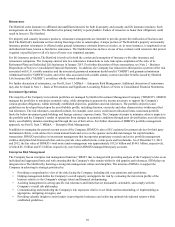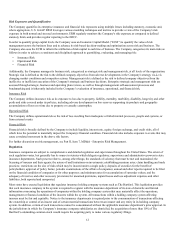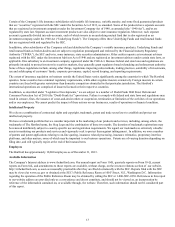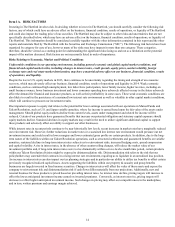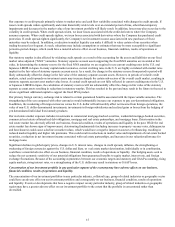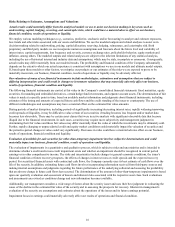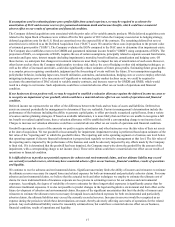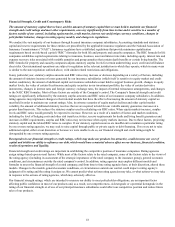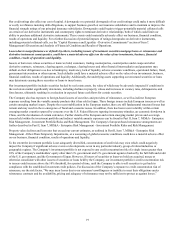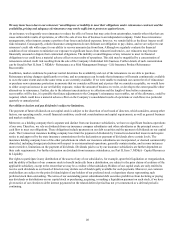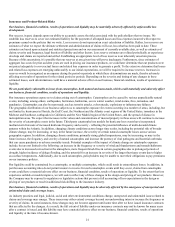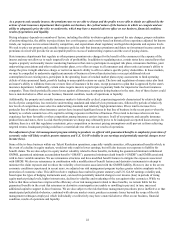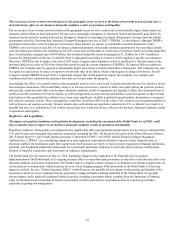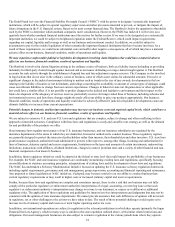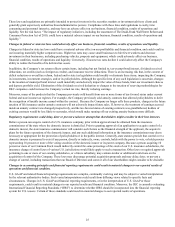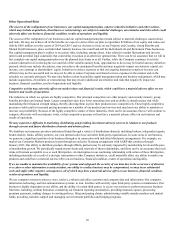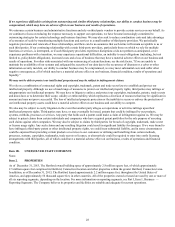The Hartford 2013 Annual Report Download - page 20
Download and view the complete annual report
Please find page 20 of the 2013 The Hartford annual report below. You can navigate through the pages in the report by either clicking on the pages listed below, or by using the keyword search tool below to find specific information within the annual report.20
We may incur losses due to our reinsurers' unwillingness or inability to meet their obligations under reinsurance contracts and the
availability, pricing and adequacy of reinsurance may not be sufficient to protect us against losses.
As an insurer, we frequently use reinsurance to reduce the effect of losses that may arise from catastrophes, transfer other risks that can
cause unfavorable results of operations, or effect the sale of one line of business to an independent company. Under these reinsurance
arrangements, other insurers assume a portion of our losses and related expenses; however, we remain liable as the direct insurer on all
risks reinsured. Consequently, ceded reinsurance arrangements do not eliminate our obligation to pay claims, and we are subject to our
reinsurers' credit risk with respect to our ability to recover amounts due from them. Although we regularly evaluate the financial
condition of our reinsurers to minimize our exposure to significant losses from reinsurer insolvencies, our reinsurers may become
financially unsound or dispute their contractual obligations. The inability or unwillingness of any reinsurer to meet its financial
obligations to us could have a material adverse effect on our results of operations. This risk may be magnified by a concentration of
reinsurance-related credit risk resulting from the sale of the Company’s Individual Life business. Further details of such concentration
can be found in Part II, Item 7, MD&A - Reinsurance as a Risk Management Strategy - Life Insurance Product Reinsurance
Recoverable.
In addition, market conditions beyond our control determine the availability and cost of the reinsurance we are able to purchase.
Reinsurance pricing changes significantly over time, and no assurances can be made that reinsurance will remain continuously available
to us to the same extent and on the same terms as are currently available. If we were unable to maintain our current level of reinsurance
or purchase new reinsurance protection in amounts that we consider sufficient and at prices that we consider acceptable, we would have
to either accept an increase in our net liability exposure, reduce the amount of business we write, or develop to the extent possible other
alternatives to reinsurance. Further, due to the inherent uncertainties as to collection and the length of time before reinsurance
recoverables will be due, it is possible that future adjustments to the Company’s reinsurance recoverables, net of the allowance, could be
required, which could have a material adverse effect on the Company’s consolidated results of operations or cash flows in a particular
quarterly or annual period.
Our ability to declare and pay dividends is subject to limitations.
The payment of future dividends on our capital stock is subject to the discretion of our board of directors, which considers, among other
factors, our operating results, overall financial condition, credit-risk considerations and capital requirements, as well as general business
and market conditions.
Moreover, as a holding company that is separate and distinct from our insurance subsidiaries, we have no significant business operations
of our own. Therefore, we rely on dividends from our insurance company subsidiaries and other subsidiaries as the principal source of
cash flow to meet our obligations. These obligations include payments on our debt securities and the payment of dividends on our capital
stock. The Connecticut insurance holding company laws limit the payment of dividends by Connecticut-domiciled insurers and require
notice to and approval by the state insurance commissioner for the declaration or payment of dividends above certain levels. The
insurance holding company laws of the other jurisdictions in which our insurance subsidiaries are incorporated, or deemed commercially
domiciled, including foreign jurisdictions with respect to our international operations, generally contain similar, and in some instances
more restrictive, limitations on the payment of dividends. Dividends paid to us by our insurance subsidiaries are further dependent on
their cash requirements. For further discussion on dividends from insurance subsidiaries, see Part II, Item 7, MD&A - Capital Resources
& Liquidity.
Our rights to participate in any distribution of the assets of any of our subsidiaries, for example, upon their liquidation or reorganization,
and the ability of holders of our common stock to benefit indirectly from a distribution, are subject to the prior claims of creditors of the
applicable subsidiary, except to the extent that we may be a creditor of that subsidiary. Holders of our capital stock are only entitled to
receive such dividends as our board of directors may declare out of funds legally available for such payments. Moreover, our common
stockholders are subject to the prior dividend rights of any holders of our preferred stock or depositary shares representing such
preferred stock then outstanding. The terms of our outstanding junior subordinated debt securities prohibit us from declaring or paying
any dividends or distributions on our capital stock or purchasing, acquiring, or making a liquidation payment on such stock, if we have
given notice of our election to defer interest payments but the related deferral period has not yet commenced or a deferral period is
continuing.


